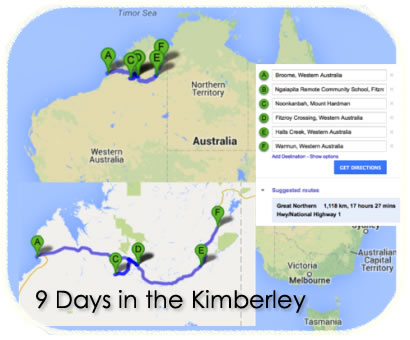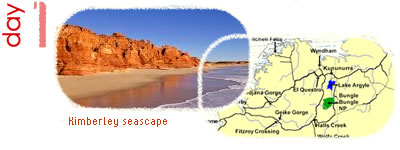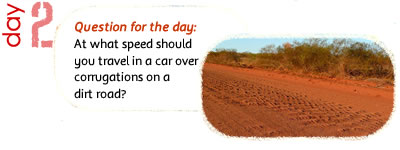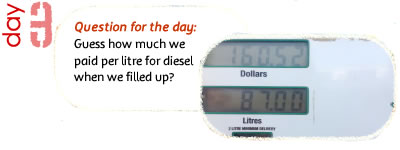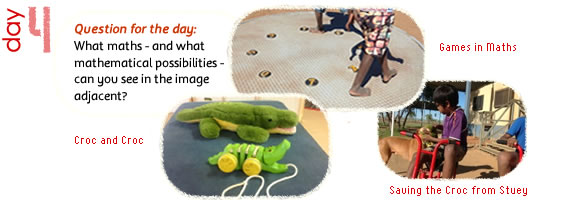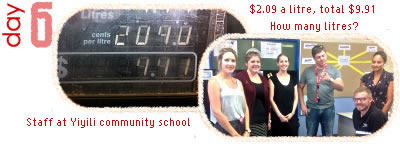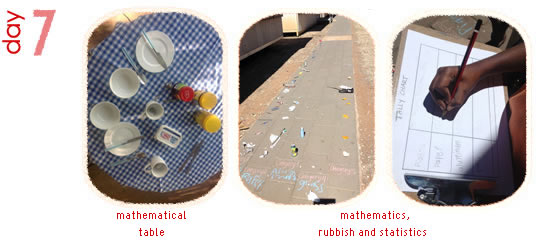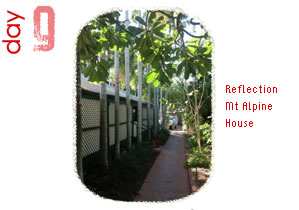Home > Indigenous Learners > Learning > Kimberley Blog
Kimberley Blog
Keep up with 9 Days in the Kimberley collaborative project with Caty Morris. Caty adds to the blog and uploads resources over the next nine days. It would be great to take the opportunity to ask questions and to provide feedback about best practice teaching and learning with Indigenous students.
| DAY 1 | DAY 2 | DAY 3 | DAY 4 | DAY 5 | DAY 6 | DAY 7 | DAY 8 | DAY 9 |
Starring: Sue, The Croc and Caty
Our quest: to discover where's the maths, what maths, whose maths and why the maths in one of the most beautiful locations in remote Australia. How lucky are we?
(Click here if you are a member of Connect with Maths to go to our photo album)
Adelaide (10 degrees) to Broome (28 degrees)
After a very early start - 5.30am departure for Adelaide airport (4am in the Kimberley!) - arrived about 9 hours and 4000kms later (lots of maths in those few words!) in Broome with my trusty crocodile - you'll find out later why he came - to be greeted by Sue.
And so the adventure starts... But first, why am I here and what am I supposed to be doing? It's not just about cruising through the beautiful Kimberley revelling in the outback landscape - which of course I'm very much looking forward to - we're not only on a quest. There's work to be done - which I'm very much looking forward to -with educators in schools in the Kimberley Success Zone. I will be sharing with them some of the great stuff that has come out of the 8 Make It Count clusters. We will also be capturing the knowledge and expertise of educators in the schools and looking for ways forward in maths for Aboriginal students in their communities. Working with teachers and Aboriginal educators, their schools and communities, is always inspirational. I feel very privileged, a bit scared, but very EXCITED!
Broome to Ngalapita
Starring: Sue, The Croc and Caty Our quest: to discover where's the maths, what maths, whose maths and why the maths in one of the most beautiful locations in remote Australia. How lucky are we?
After a hearty breakfast in downtown Broome and picking up the meat for the bbq tonight and dubious packing it into the car back of the Toyota (Sue's a Literacy person...), we travelled for four hours into the bush. About a third of the way into the journey and still on the bitumen highway, we drove over the one-way bridge where a serious accident had occurred in the previous week between two semi-trailers. The trucks were heading towards each other and were unable to stop in time to give way and allow one or the other to cross the one-lane bridge (the speed limit for crossing bridges is 80km/hour).
One of the trucks had been carrying trailers full of cattle. Many of them died as a result of the accident. The bridge was closed for the day causing complications including 300 people being stranded at a nearby roadhouse, people missing flights out of Broome and teachers not being able to make it back to their communities' schools. About two and a half hours later and some bumpy travel we arrived at the community of Ngalapita and were welcomed by the principal Jan Ladhams and a group of around 15 teachers engaged in the last couple of units of the FSIM Measurement Course - beautiful! At the end of the day (5.30pm in fact - clearly very dedicated teachers - and it was Saturday night) we looked at some of our Make it Count stuff i.e. the Cluster Findings, a walk through the Clusters' foci, our developing website (available soon and Connect with Maths Indigenous community will be one of the first to find out), the CWMI site, and the drop drawer postcards (top drawer is on the AAMT website).
It was very inspirational to see these teachers in action and the great work of Jan Ladhams who was running the PD. Jan is an excellent facilitator and knows the maths deeply - a great asset for the school and the region. It would be interesting to see whether the FSIM diagnostic tasks reveal any common misconceptions in students across the schools. We then proceeded with the BBQ (see images) in which a couple of families joined in. Norman, a very gentlemanly and patient Elder, attempted to teach me some local language ('marlu' is kangaroo in both Pitjantjatjara and Walmajarri). Later on we sat around the fire toasting marshmellows and telling maths stories...
Question for the day: At what speed should you travel in a car over corrugations on a dirt road? Please respond with your answers!
Ngalapita with a visit to Millijidee community
It's Sunday morning and we had breakfast with the teachers over in the staff room. There they all were talking maths and busy getting copies of some of Jan's great work - the collaboration and sharing of resources and expertise at 9am on a Sunday morning was tremendous! Everyone then headed back to their various communities, many with 2-3 hour trips in front of them.
The rest of the day was spent mostly at Ngalapita in conversation with Jan about some of the school's plans such as the tree planting project full of mathematics learning opportunities no less. We had some discussions about how to use home language such as local Kriol to teach the technical or mathematical language required by the Australian Curriculum and how home maths and school maths can 'collaborate'. Please comment if you have any ideas or thoughts on this...
We also fitted in a quick visit to Millijidee to say hello to some community people. The Croc managed to crawl his way out of the Toyota to play with some children and finally proved his worth - more soon about him...
Some advice from the school about teaching maths: break down the concepts into increments and teach it step by step and practise and practise. 'Numero' is a great game for teaching concepts and maths apps 'monster physics' and 'geoboard' work well.
Question for the day: Guess how much we paid per litre for diesel when we filled up?
Ngalapita to Noonkanbah to Fitzroy Crossing
We're still at Ngalapita and school begins at 8.00am. Sue, The Croc and I wandered over to meet some of the students and The Croc and I engaged in a very interesting conversation with two Year 6 boys who told us a story about crocodiles, pigs and dogs 'down the river'. The boys used many Kriol words that had some sort of mathematical inference e.g. 'down', 'that way' and 'little bit'. They spoke using numbers of different animals in their stories which could easily be represented by algorithms and algebraic equations. (I know many teachers already do this and I'd be interested to hear about some examples of this in action…) While keeping me entertained and educating me, they also managed to prevent The Croc from becoming the equation 1 - 1 = 0 by Jan (the principal's) dog Stuey!
We then joined 'the circle' of students and teachers (Stronger Smarter strategy). We took it in turns to say what we wanted to be when we grew up. Students' responses included 'station manager', 'footballer' and 'teacher'. With Jan's expertise in mathematics and impact in the classroom I expect they will soon be saying 'mathematician'!
While driving to our next destination, I kept thinking about the maths in kids' stories and teachers being able to identify the maths and use it to teach (and learn). How can teachers access and use that story language to deepen kids' conceptual understandings. How can/do teachers identify the concepts and language students are using... (Soon I hope to show you the video of the boys telling me their stories). Sue and I had some interesting discussions about teachers recognising and understanding the rich knowledge children bring with them to school.
We soon arrived at Kulkarriya Community School at Noonkanbah and took The Croc to visit the Irlee Bird Learning Centre for 0-4 year olds. The Croc was in his element and even found a smaller croc to play with. My newly found four year old friend was quick to tell me which croc was 'bigger' and which one was 'smaller' (see image left). The Croc also managed to help tidy up the classroom room by picking up about 5 railway tracks and putting them away...
The children then went outside to play on the equipment and once again we were engulfed by an incredible amount of maths! That is, the play equipment itself and the activities and play the children were participating in was so rich in maths (see photo below). Children were physically doing the maths e.g. rotating around in circles, getting up and down from equipment, counting out loud as they were swinging from one bar to the next, walking over beams, scaling ladders etc. Not being an early years educator, it opened my eyes to all those wonderful opportunities teachers have in those years to match children's activity with maths language and symbols.
Question for the day: What maths - and what mathematics potential - can you see in the image above?
Fitzroy Crossing to Yiyili to Hall Creek
The morning began with a stop at Fitzroy Crossing School with its interesting and creative architectural features and a passing view of the amazing architecture of the Family and Children's Centre built in the shape of a stingray. Then on to Yiyili Aboriginal Community School. We met the fabulous staff at Yiyili and showed them some of our work in Make it count. It was pretty exciting seeing Corrie Baxter and Lizzie Gilligan again - after they presented at the AAMT Special Interest Conference in October last year - and to actually be in their school and classrooms, and witness what they talked about so enthusiastically at the conference. The school's principal, Nick Try, was interested in the model for responsive mathematics pedagogy Make it count has developed as a result of the work done in our 8 clusters, i.e. pedagogy that is culturally, socially and academically inclusive to Aboriginal students' learning needs in mathematics. Nick made the comment that this could/should apply to any curriculum area.
Later that night we met with Di Tomatzos, Liz Jerrat, and Clifton Fong over dinner at Halls Creek and covered many topics including some of their findings through their careful assessment of 4-5 year old students (see Day 6).
Sue and I had many stimulating conversations along the way about broad topics including:
- how critical the relationship between the Aboriginal educators and teacher is and the importance of building on this
- the many people who are very enthusiastic and speak very positively about students and families - the cup is half full rather than half empty (now that's sounding mathematical!)
- that the development of pedagogy is extremely important and teaching maths shouldn't be reliant of implementing resources and programs only. Teachers who are about 'next practice' are generally better able to use resources more effectively and use them to deepen their mathematical content and pedagogy knowledge
- using kids physicality to develop western maths concepts - students are very active and doing all sorts of physical movements in play and in the classroom
- being able to see the knowledge and understandings in everyday life that can be incorporated into teaching and learning programs
Halls Creek to Yiyili to Warmun
An early morning start sees the three of us on our way from Halls Creek back to Yiyili community for some closer interaction with this engaging school. We talked with staff and helped celebrate Alex's (one of the committed staff ) birthday over morning tea. During a look around the school we could see maths everywhere (see images) and some great examples of code switching (from Gooniyandi to Kriol to Standard Australian English [SAE]).
This was followed by a great conversation with Lizzie and Frances, two of the school's Aboriginal educators, about language, teaching maths, and working in partnership with teachers (we will have some video/audio snippets of this available soon). Some of their important insights were about the knowledges Aboriginal kids
bring with them to school eg the numeracy concepts students already have (such as subitising maybe) and how teachers need to be able to understand and access these to teach the SAE maths language required by the Australian Curriculum Maths. Lizzie talked about the collaboration between the proposed ranger program and the school and we immediately thought of the potential for a bush maths project ie identifying the maths in the bush leading to the development of a resource.
Does anyone know of any work, resources or research done in this area?
We then set off for Warnum, about a 3 hour drive west through some beautiful country. Arriving in Warnum we settled into our residence, the Mirrilinki Centre, for the night after a short walk to the roadhouse for a very tasty steak sandwich. Note how much more diesel is here (see image)! Sitting outside the roadhouse Sue and I contemplated the fabulous things we'd seen for the day and felt motivated and encouraged by the resilience of both students and teachers in the face of floods, fires, isolation etc and reflected on the genuine care and commitment the teachers demonstrated for kids and families.
Warmun to Halls Creek
We begin the day with our usual toasted muesli and yoghurt at a very well set mathematical table and arrive at Ngalangangpum school to be greeted by the principal Leanne who was busy mending the school bell. Once school began we were led to a classroom where the Aboriginal educator was reading from the interactive white board, an adaption of Goldilocks and the three bears that had been re contextualised by senior students to become Goldie. Now, being ever alert to converting literacy to numeracy I couldn't help seeing all the maths bound up in this revised story. There was maths terminology sprinkled throughout and my mind wondered as to how 'meaningful chunks of text' steeped with mathematical language could be used to teach maths concepts and mathematical language eg 'who bin layin on my rock mattress', 'back of the cave'. It was then that I made the link with Phil Clarkson's recent and excellent presentation at the AAMT conference (click here for image).
It also reminded me of conversations I've had with Chris Matthews and Tyson Yunkaporta from ourMake it count project that maths can be viewed like its a story with a beginning, a middle and an end - we start with a thing/number/etc, something happens to it (such as an operation), and this is what we end up with. Complimenting these conversations with teachers about starting with the whole, then going to the parts and ending again with the whole in lesson planning.
After morning tea we witnessed a great lesson with year 5 students and their teacher, Cim Vandepol. The lesson was based on categorising rubbish from the playground and building a graph on the pathway using its and all of which occured outside. Various students were assigned roles such as timekeeper and recorder.
Cim is a very creative and inspiring teacher and the lesson was a great example of how maths teaching moves from the concrete to the abstract. The walls of their classroom were alive with their learning giving Sue and me plenty to talk about and to share with others. The Croc even got to see a caricature of his species. Thanks Cim and your Year 5 kids!
We then journeyed back to Halls Creek for the night. Contemplating the excellent teaching and learning we have seen, the stimulating conversations we have participated in and the great opportunities we have had the privilege to engage in ...
Halls Creek to Broome
The morning begins with us trying to track down a soy latte. Can you believe, I've met someone else who likes them as much as I do!! But alas, no luck - they'd run out of soy milk...
Our first stop before our 8 hour journey back to Broome was to see the maths 'magician' Di Tomatzos at Halls Creek District High School (see image) at work. Di showed us some of the impressive work she has done with assessing kindergarten children with diagnostic tasks. Like Sue and me, The Croc was very impressed with what he saw and wanted to set up camp on Di's desk. Sue was also very impressed with the power of video in that teachers can view them together and discuss and critique teaching and learning, appropriate focus questions to ask students to draw out their thinking, students pre, partial and conceptional understandings and possible misconceptions. Di had videos of students taken early and late in the year and their growth was very obvious. Video is a powerful and valuable form of data.
The three of us had an interesting conversation about the 'silver bullet' syndrome which distracts educators from focussing on pedagogy as they keep looking for the latest resource or program. Of course these have a place but it is pedagogy that will the difference will be made and in how such programs can support and enhance the development of responsive maths pedagogy.
We farewelled Di and set off on our last leg of our 'Thelma and Louise' journey after filling up with relatively cheap diesel - compared with other places we had filled up. Along the way Sue was very impressed by our ability to use her phone's hotspot to send emails via my laptop while uploading photos right here in the middle of the remote Kimberley! (See image).
Finally we arrive in Broome just before the sun began to set and made our way to my lodgings for the night.
Broome to Adelaide
Sue picked The Croc and me up from the century old McAlpine House and over breakfast we reviewed our week in the Kimberley. Our breadth of work included over 2000 km of travel over 7 days with visits to 7 school communities. We spoke with principals, numeracy coaches,teachers, Aboriginal educators, students, parents and grandparents. We engaged in professional learning with a group of teachers from 5 schools; we saw classroom teaching in one school; we had in depth discussions with 2 committed Aboriginal educators on their perspectives on maths, their roles and what teachers need to know; we presented on Make it Count twice, and dined out with the principal, curriculum coordinator and maths coach from another school.
There were many highlights and strengths we found including the professionalism of teachers, the quality and expertise of several maths education specialists, the valuable contribution that Aboriginal educators make, pockets of incidental research currently being undertaken on a small scale that have real potential to be developed and shared, people seeing the value in collaboration, and a real willingness to learn from others (as well as a real need to leverage the expertise) and opportunities to work with.
We see many possibilities or potential initiatives for Kimberley projects in maths that could be developed through partnerships and we have a number of ideas and concepts that have been incubating on the long drives and look forward to considering these further and talking more with people about these.
We have also begun shaping our thinking around a paper / resource that will offer practical ideas for the schools in their work to improve learning outcomes of Aboriginal students across the Kimberley…so stay tuned.
I left a warm, 28 degree morning in Broome and arrived back in Adelaide 11 hours and 4,000 km later to a cold, wet, bleak Saturday night and my three gorgeous daughters and husband!
Cheers from Caty and the Croc who left Sue behind to process the ways Kimberley Success Zone can leverage AAMT resources, learning communities and relationships strengthened during this exciting week.

